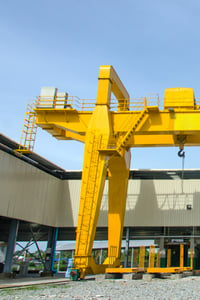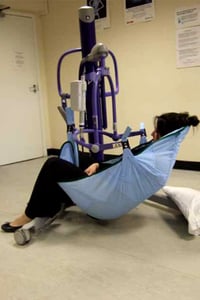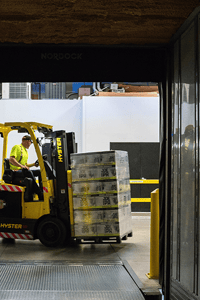LOLER is the abbreviation for the The Lifting Operations and Lifting Equipment Regulations (1998), which is the UK Government’s official regulation for people and companies who own, operate, or have control over, all types of lifting equipment. It falls under the Health and Safety at Work etc Act 1974 and it's in place to ensure that all lifting equipment is suitable and safe for use.
LOLER regulations require that all lifting operations must be properly planned by a ‘competent person’, as well as appropriately supervised and carried out safely. This means that workers must be properly trained to use lifting equipment, sites should be properly inspected and any work must be planned thoroughly by somebody with appropriate experience and knowledge before any lifting operation takes place.
In addition to the planning and supervision of lifting operations, LOLER requires that all equipment used for lifting is regularly maintained, inspected and suitably marked to indicate that it is fit for purpose. In many cases, this involves regular thorough examinations and inspections, where lifting equipment is checked by a 'Competent Person' for any defects. These are then reported to the person responsible for the equipment and possibly the relevant enforcing authority, depending on the defect.
LOLER applies to a range of lifting equipment used at work across different industry sectors. Some examples of the different types of equipment covered by the LOLER regulations include:




Although LOLER covers a wide range of lifting equipment and their potential accidents, there are some exceptions that aren’t covered by the regulation, such as pallet trucks (where there is a low chance of the load falling) and escalators.
It is important to note that, regardless of LOLER, all equipment should be maintained in accordance with The Provision and Use of Work Equipment Regulations 1998 (PUWER).

Under LOLER regulations, this equipment must have been subjected to thorough examinations and marked with a safe working load in order to be compliant. Thorough inspection is necessary to ensure that lifting equipment is safe to perform lifting operations with minimal risk throughout its lifecycle. The LOLER regulations state that a thorough inspection should be completed at regular intervals throughout a number of different situations, including:
This isn’t always necessary, but is essential when there is not a valid Declaration of Conformity made less than 12 months earlier.
This is when the lifting equipment is exposed to conditions that could result in danger or damage. For examples of this in specific types of equipment, please read our blog.
This includes re-installation and assembly of the lifting equipment at another site.
In order to maintain standards and stay in-line with LOLER regulations it’s important that your equipment checks and inspections are completed at regular intervals (weekly/monthly/quarterly).
The HSE offers guidance to employers on how regularly these inspections should take place.
At its most simplistic, lifting equipment and accessories relating to devices which lift people should be inspected every 6 months whilst larger equipment meant for non-human lifting should be inspected every 12 months.
Under the Health and Safety at Work etc Act 1974, it is an employer’s legal responsibility to provide a safe working environment and LOLER falls under this requirement.
According to HSE’s Guide to Lifting Equipment at Work, if you are an “employer or self-employed person providing lifting equipment for use at work”, or if “you have control of the use of lifting equipment” then the LOLER regulations will apply.
If you fall under either of these categories, you are classed as a 'duty holder' in the eyes of the HSE. It is, therefore, your responsibility to ensure that all lifting equipment in your possession meets the requirements of LOLER.
Both regular inspection and thorough examination are key requirements of LOLER. Lifting equipment that is “exposed to conditions causing deterioration which could lead to dangerous situations” must be subjected to regular thorough examination by a competent person.
Duty holders must ensure that all lifting equipment and accessories are sufficiently strong, stable and suitable for the proposed task, which often requires testing services.
LOLER requires duty holders to make sure that equipment in their possession is visibly marked with any information that should be taken into account for its safe use. This includes safe working loads and usage instructions.
Under LOLER, all lifting operations should be planned, supervised and carried out safely by people who are deemed competent by the duty holder.
Following a thorough examination, the competent person must submit reports to the employer for any appropriate actions required. As the duty holder, you must also keep relevant information relating to your lifting equipment, including these reports, LOLER inspection documentation and EC Declarations of Conformity.
The term ‘competent person’ can be subjective. However, the HSE defines a competent person as someone with "appropriate industry knowledge and experience working with the specific type of equipment in order to thoroughly examine to an excellent standard, identify any issues and report their findings". By selecting a person with these skills, you can be sure that they are qualified to analyse the importance of any defects the equipment has, as well as having peace of mind that they will be able to evaluate these in relation to the continued safe use of the item being inspected.
It is important to remember that the competent person you choose to do the inspection is independent and impartial, so that decisions that could compromise the safety of the lifting equipment aren’t made based on personal or company bias.
As long as you appoint a person based on these competencies, the HSE allows you the freedom to choose who you like. However, while LOLER does not expressly condemn the person carrying out the maintenance from also conducting the examination, it is strongly recommended that the inspector you choose should not be the person in charge of performing regular maintenance.
This is because they would be inspecting their own work, which opens itself up to potential bias. Not only this, but there are additional benefits that come with outsourcing an inspection supplier, such as an increased chance that they will be able to spot defects and rectify them.
A thorough examination is defined by the HSE as a “systematic and detailed examination of the equipment and safety-critical parts”. It is carried out at specified intervals by a competent person who must then complete a written report once the examination is complete.
When your equipment requires an examination, a competent inspector will come to your business and perform it. The examination generally consists of three stages:
When a defect is identified that could cause harm to people, you will be notified immediately by the inspector. Once you have been made aware, it is your responsibility to take direct action to manage any risks by ensuring the defect is highlighted and that no employee uses the equipment until it is fixed.
Under LOLER regulations, it is strongly recommended that you take time to make a record of the defect - even if it is repaired immediately. The reason for this is so that you are able to keep track of all equipment testing and make records of defects in case they occur again in the future. This will ensure the continued safe use of the equipment throughout its lifecycle.
Accurate record-keeping is just as important to LOLER regs as the inspection and testing. How can you prove that an inspection has taken place if your records are all over the place?
Alongside your thorough examinations reports, there are two other types of records which must be kept. They include EC Declaration of Conformity (DoC) (soon to be UKCA) & records of inspection.
For thorough examination reports - if one lacks the DoC - a copy of the initial report for lifting equipment should be kept for the life of the machinery. Reports which cover lifting accessories should be kept for two years after examination.
The EC Declaration of Conformity - soon to be UKCA DoC - is a statement to confirm that the lifting equipment meets the requirements of the Machinery Directive. The owner should retain this document for the life of the equipment.
Lastly, in-service inspection. These are often based on manufacturer’s recommendations and instructions. More general, in-service inspections should be routine in order to spot defects and issues early. These reports should be kept until the following inspection takes place and supersedes it.
If companies are found to be non-compliant with LOLER, they can be subjected to serious penalties ranging from large fines to prosecution.
With this in mind, it's essential to make sure that your inspector is compliant.
The inspector you choose should be qualified to do the examination in accordance with LOLER regulations and be able to identify faults in your equipment and act accordingly based on their findings. They should have the relevant experience and attributes as specified by LOLER, to make them competent to undertake the examination.
There is no set definition of ‘experience’, but it must be substantial and appropriate - the inspection provider you choose needs to have significant knowledge of the industry, as well as a number of years of experience working with the specific equipment that needs to be inspected. This is important, because not every inspector will have the same amount of experience.
An inspector’s key attributes vary depending on the type and scale of the lifting equipment. To find out what these are, you need to look into:
Accreditations and Memberships
These include SAFed which plays a key role in maintaining high standards of safety within the workplace and LEEA, the leading trade association for all those involved in the lifting industry.
Reputation
Be sure to choose an inspector based on their company’s reputation; for example, look into how long they have been conducting examinations and reviews from other clients.
In an industry where every lost hour of production can directly impact day-to-day business, you need a competent inspection supplier who is able to examine your equipment to a high standard with minimal disruption.
With Lloyds British, you not only gain assured competence and compliance, but peace of mind.
For over 200 years, Lloyds British has been helping businesses across the lifting services industry be compliant with LOLER regulations with specialist testing, inspection, maintenance, certification and training. Our long list of accreditations and memberships is your guarantee that we deliver our services efficiently, effectively and in line with LOLER regulations, health and safety standards and industry best practices.
If you'd like assistance with your LOLER inspection requirements, get in touch with us today. Our industry experts are on hand talk to you about your specific needs. We offer:
Simply tell us your requirements in this form and one of our experts will be happy to assist you.